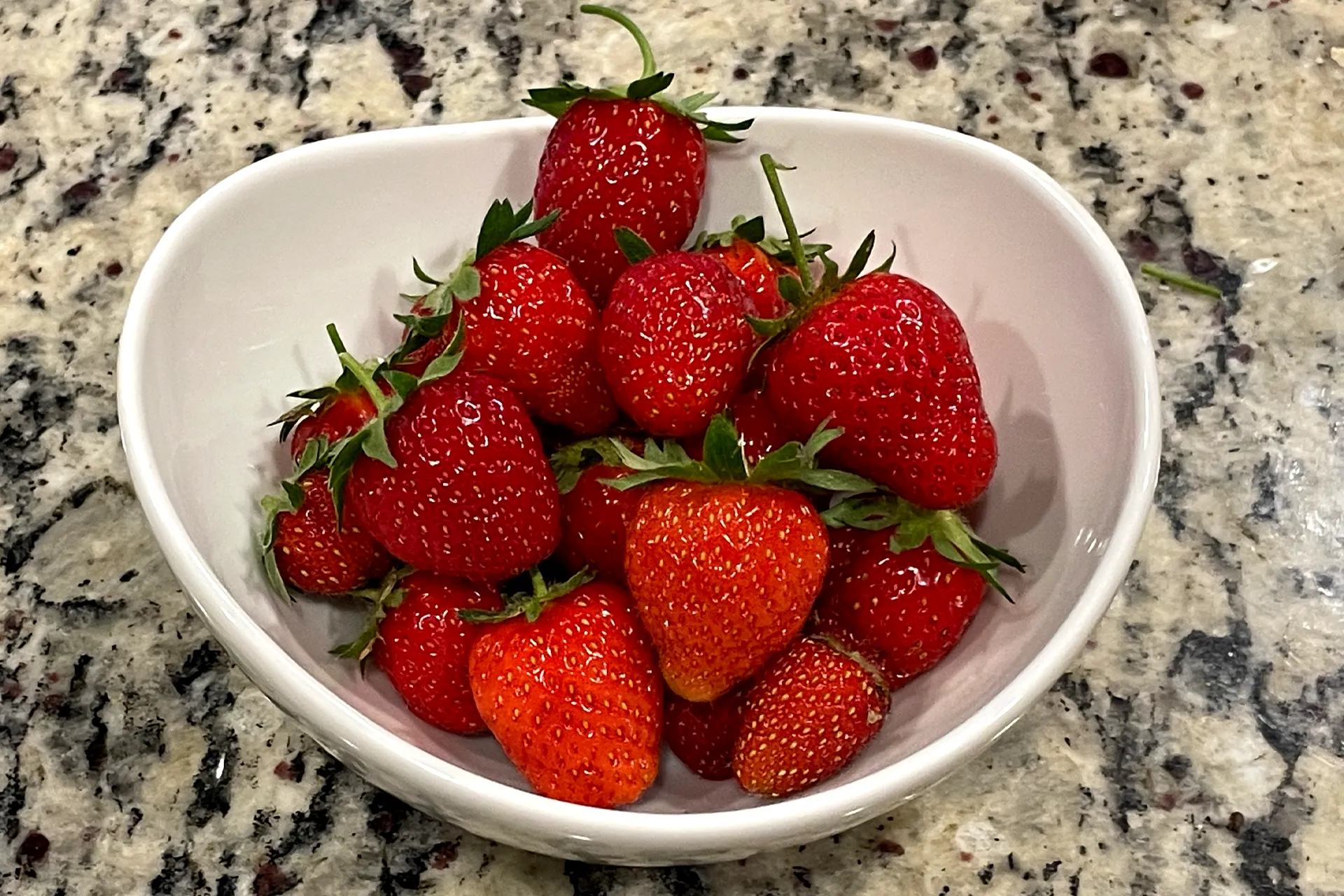This post may contain affiliate links. When you purchase through links on my site, I may earn a commission at no cost to you. See my Privacy Policy for details.
Are you ready to embark on a fruitful adventure in your garden? Growing strawberries is a delightful and rewarding experience that allows you to enjoy the juicy, sweet taste of these luscious fruits right from your backyard. Whether you have a spacious garden or a small balcony, strawberries can be cultivated in containers, raised beds, or traditional garden beds. In this beginner’s guide, I will walk you through the process of growing strawberries, from selecting the right variety to harvesting the ripe, red berries. So put on your gardening gloves, grab your trowel, and let’s get started on this berry-licious journey!
Strawberries are a delicious and nutritious fruit that can be easily grown in your backyard. Not only are they a great addition to your garden, but they can also save you money in the long run. Store-bought strawberries can be expensive, but growing your own can be a cost-effective solution. Plus, there’s nothing quite like the taste of fresh, homegrown strawberries.
Choosing the Right Variety
When it comes to growing strawberries, choosing the right variety is crucial. There are three main types of strawberries to choose from: June-bearing, everbearing, and day-neutral. Each type has its characteristics and advantages.
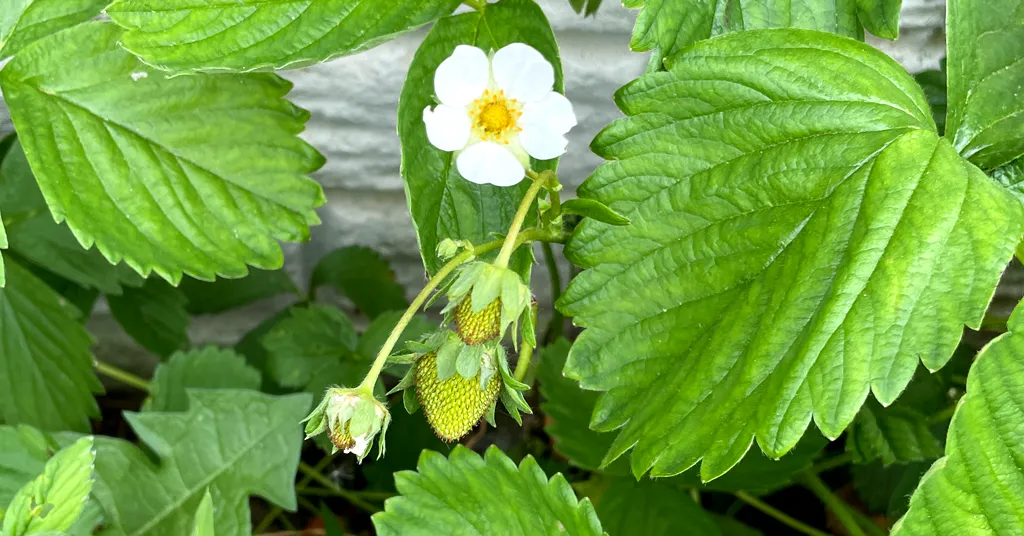
June-Bearing Strawberries
June-bearing strawberries, as the name suggests, produce fruit in June. They are the most common type of strawberry and are known for their large fruit size and intense flavor. If you’re looking for a large harvest of strawberries at once, June-bearing strawberries are the way to go.
Some popular varieties of June-bearing strawberries include:
Everbearing Strawberries
Everbearing strawberries produce fruit throughout the growing season, with the heaviest harvest in June and another smaller harvest in the late summer or early fall. They are a great choice if you want a continuous supply of strawberries throughout the season.
Some popular varieties of everbearing strawberries include:
- Seascape
- Quinault
- Ozark Beauty
Day-Neutral Strawberries
Day-neutral strawberries produce fruit continuously throughout the growing season, regardless of the day length. They are a good choice if you want a steady supply of strawberries but don’t want to deal with the hassle of managing the harvest times of June-bearing or everbearing strawberries.
Some popular varieties of day-neutral strawberries include:
- Albion
- Tristar
- Tribute
When choosing a strawberry variety, it’s important to consider factors such as flavor, fruit size, and disease resistance. Take the time to research different varieties and choose the one that best fits your needs and preferences.
Methods of Growing Strawberries
When it comes to starting your strawberry patch, you have a few options to consider: growing from seeds, planting bare-root plants, or purchasing nursery plants. Each method has its advantages and considerations, so let’s explore the different approaches to growing strawberries and how to make the best choice for your gardening preferences.
Starting from Seed
Growing strawberries from seeds can be an exciting and rewarding process, though it requires a little more time and patience compared to other methods.
- Begin by selecting high-quality strawberry seeds from a reputable supplier. It’s important to note that not all strawberry varieties produce true-to-type seeds, meaning the resulting plants may have different characteristics than the parent plant.
- Start your seeds indoors in trays or pots about 8 to 10 weeks before your intended planting date. Sow the seeds in a well-draining potting mix, covering them lightly with soil.
- Maintain consistent moisture and provide ample sunlight or artificial grow lights to encourage healthy seedling growth. Transplant the seedlings into individual containers once they develop a few sets of true leaves.
- After the threat of frost has passed and the seedlings have grown stronger, you can transplant them into the garden bed or desired containers, ensuring proper spacing between the plants.
Starting from Bare Root Plants
Bare root plants are another common way to establish a strawberry patch. These are dormant strawberry plants that are sold without soil around their roots.
- Purchase bare root plants from a reputable supplier or local nursery. It’s important to inspect the plants upon arrival to ensure they are healthy, with no signs of disease or damage.
- Before planting, soak the bare root plants in water for a few hours to rehydrate their roots and prepare them for planting.
- Choose a location in your garden or containers with well-drained soil and adequate sunlight. Dig holes or trenches wide and deep enough to accommodate the roots of the bare root plants, ensuring proper spacing between each plant.
- Place the bare root plants in the holes, ensuring the crown (where the roots meet the leaves) is level with the soil surface. Backfill the holes with soil, gently firming it around the roots to eliminate air pockets.
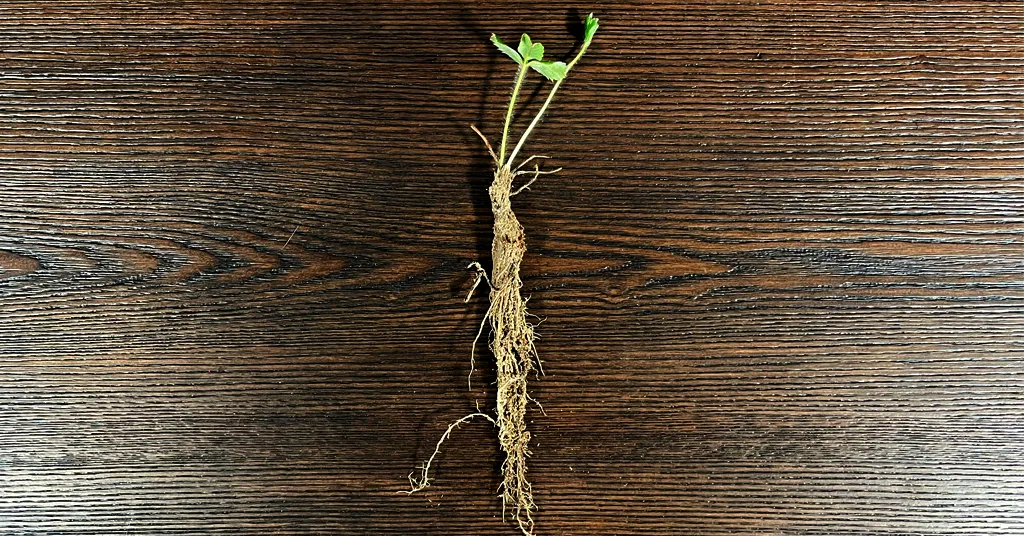
Starting from Nursery Plants
Buying nursery-grown strawberry plants is a convenient and popular option, especially for beginner gardeners or those looking for specific strawberry varieties.
- Select healthy nursery plants from a reliable source. Look for plants with vibrant green foliage and well-developed root systems.
- Choose a planting site that meets the sunlight and soil requirements of the specific strawberry variety you’ve purchased. Prepare the soil as necessary, removing weeds and incorporating organic matter for improved fertility and drainage.
- Dig holes or trenches according to the spacing guidelines provided with the nursery plants. Gently remove the plants from their containers, taking care not to damage the roots. Place the plants in the holes, ensuring the crown is level with the soil surface and backfill with soil.
Preparing the Soil to Grow Strawberries
If you want to grow delicious and healthy strawberries, you need to start with good soil preparation. This section will cover the three main sub-sections of preparing the soil: Site Selection, Soil Preparation, and Fertilization.
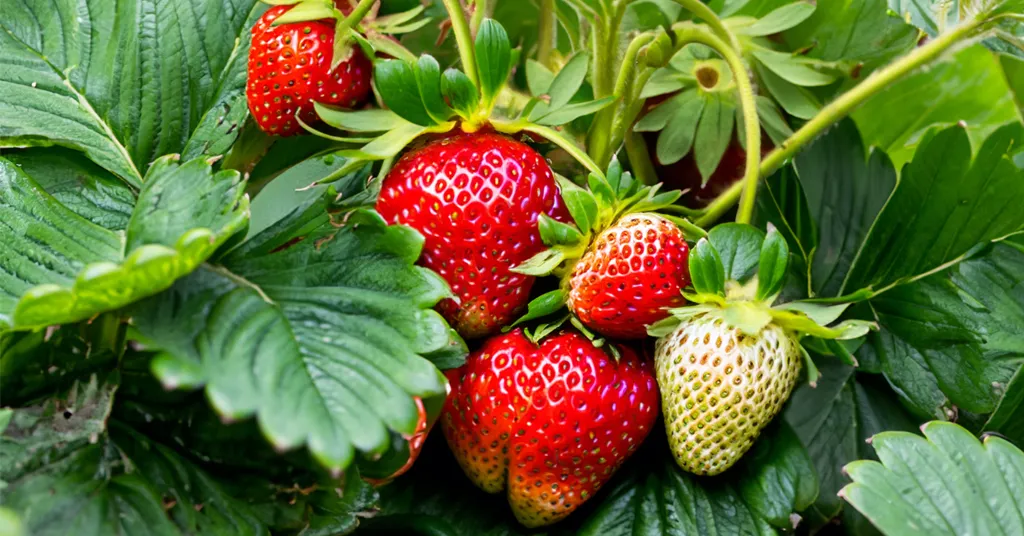
Site Selection
Choosing the right site for your strawberry plants is crucial. Here are some tips to help you select the best site:
- Choose a warm and sunny location that gets at least 8 to 10 hours of sunlight each day.
- Make sure the area is free of weeds and other plants that could compete with your strawberries.
- Avoid planting in areas that are prone to flooding or have poor drainage.
Soil Preparation
Once you have selected the right site, it’s time to prepare the soil. Here are the steps to follow:
- Remove any weeds and rocks from the planting area.
- Loosen the soil to a depth of at least 6 inches using a garden fork or tiller.
- Add organic matter such as compost, aged manure, or peat moss to improve the soil’s fertility and structure.
- Mix the organic matter into the soil to a depth of at least 4 inches.
- Level the soil and create raised beds if necessary.
Fertilization
Strawberries require a lot of nutrients to grow properly. Here are some tips for fertilizing your strawberry plants:
- Use a balanced fertilizer with equal amounts of nitrogen, phosphorus, and potassium.
- Apply the fertilizer according to the manufacturer’s instructions, usually in early spring and again in late summer.
- Avoid over-fertilizing, which can lead to excessive foliage growth and poor fruit production.
By following these steps for preparing the soil, you can create the ideal growing conditions for your strawberry plants. With a little bit of care and attention, you can enjoy a bountiful harvest of sweet and juicy strawberries.
Planting Strawberries
When it comes to growing strawberries, getting the planting timing and spacing just right is essential for ensuring healthy plants and a bountiful harvest. Let’s delve into the importance of selecting the optimal planting time and spacing for your strawberry plants.
Timing
Choosing the right time to plant your strawberries is crucial for their successful establishment and growth. The ideal planting time may vary depending on your climate and the specific variety of strawberries you intend to grow. Let’s explore the optimal planting times for different regions and why early spring and late fall are generally recommended.
- Early Spring Planting:
- For most regions, early spring is considered the prime planting season for strawberries. This timing allows the plants to establish strong root systems before the hot summer months.
- As the temperatures begin to warm up and frost is no longer a concern, it’s time to get your strawberry plants in the ground. This typically falls between March and April in many temperate climates.
- Planting in early spring provides the strawberries with ample time to settle in, develop healthy foliage, and set flower buds, leading to a fruitful harvest in the coming months.
- Late Fall Planting:
- In regions with mild winters, planting strawberries in late fall can also be a favorable option. This timing allows the plants to take advantage of the cooler temperatures and establish themselves before the dormant period.
- Late fall planting is typically recommended in areas where the winters are mild and the soil remains workable. Aim to plant your strawberries around October or November, depending on the local climate.
- By planting in late fall, you give the strawberry plants a head start in rooting and preparing for the following growing season. The cool temperatures during winter promote root development and overall plant vigor.
Why Early Spring and Late Fall?
Early spring and late fall are preferred planting times for strawberries due to several reasons:
- Mild Temperatures: Both early spring and late fall offer milder temperatures that are conducive to strawberry growth. Extreme heat in summer can stress the plants, while frosty conditions in winter can harm the tender foliage. Planting during these moderate seasons provides optimal conditions for the plants to establish and thrive.
- Root Development: By planting in early spring or late fall, you give the strawberry plants ample time to focus on root development. Strong and well-established roots ensure efficient nutrient uptake and water absorption, leading to healthier plants and better fruit production.
- Flowering and Fruit Set: Early spring planting allows the plants to develop strong foliage and flower buds, which are essential for fruit production. Late fall planting ensures that the plants are well-rooted and ready to burst into bloom when the growing season arrives. Both timings maximize the chances of a bountiful harvest.
- Disease and Pest Management: Planting strawberries outside of the peak growing seasons can help minimize the risk of certain diseases and pests. For example, planting in early spring reduces the likelihood of encountering common fungal diseases that thrive in warm, humid conditions.
Remember, it’s important to consider your specific climate and local conditions when determining the optimal planting time for strawberries. Consulting with local gardening experts or contacting your cooperative extension office can provide valuable insights into the best timing for your specific area.
Optimal Plant Spacing for Strawberry Plants
Proper plant spacing allows for adequate airflow, sunlight penetration, and efficient nutrient uptake. Whether you’re growing strawberries in a garden bed, containers, or raised beds, here are some guidelines to help you achieve the ideal plant spacing:
- Garden Bed Planting:
- In a traditional garden bed, aim for a spacing of 12 to 18 inches (30 to 45 cm) between individual strawberry plants.
- Leave approximately 2 to 3 feet (60 to 90 cm) of space between rows to provide enough room for the plants to spread and produce runners.
- This spacing allows each strawberry plant to develop a strong root system and ample foliage without overcrowding, which can lead to poor airflow and an increased risk of diseases.
- Container Planting:
- When growing strawberries in containers, choose pots or containers that are at least 8 to 12 inches (20 to 30 cm) deep and wide enough to accommodate the root system of the plants.
- For a single strawberry plant, a container with a diameter of 8 to 10 inches (20 to 25 cm) should be sufficient. If you plan to grow multiple plants in the same container, increase the pot size accordingly.
- Maintain a spacing of about 12 inches (30 cm) between each strawberry plant in the container to allow for proper growth and prevent overcrowding.
- Raised Bed Planting:
- Raised beds offer excellent drainage and allow for better control over soil quality. In a raised bed, plant strawberries with a spacing of 12 to 18 inches (30 to 45 cm) between individual plants.
- Leave approximately 2 to 3 feet (60 to 90 cm) of space between rows to provide enough room for runners to spread and develop new plants.
- If you have multiple raised beds, ensure there is enough space between them to facilitate easy access for maintenance and harvesting.
By providing adequate spacing between strawberry plants, you promote healthy growth, minimize the risk of diseases, and maximize the productivity of your plants. Proper spacing also allows for better air circulation, which helps prevent fungal infections and other common strawberry diseases.
Additionally, maintaining a reasonable distance between plants makes it easier to access the plants for regular maintenance tasks like watering, weeding, and harvesting. It also ensures that each plant receives sufficient sunlight, which is crucial for photosynthesis and fruit development.
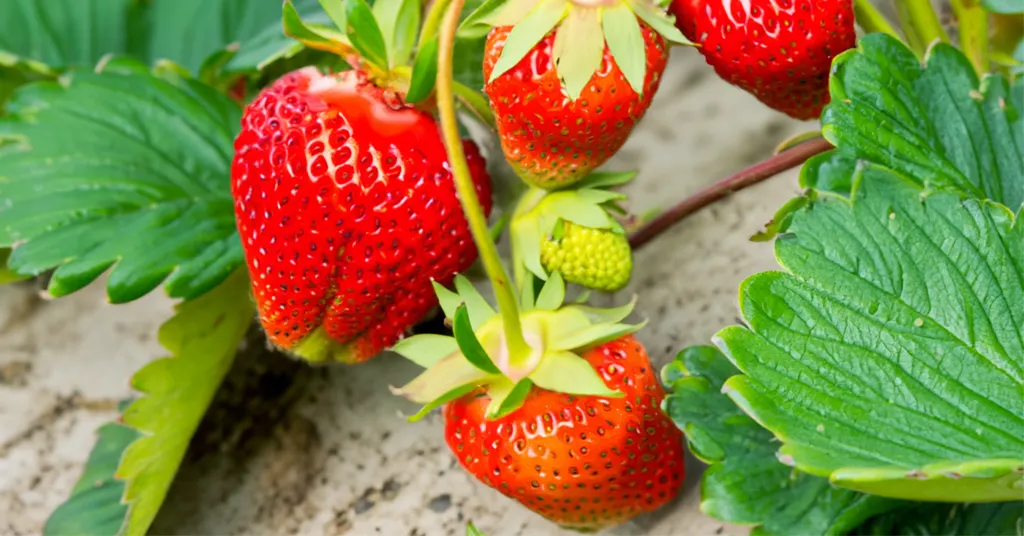
Watering Strawberry Plants
While strawberries require consistent moisture, it’s important to strike the right balance and avoid overwatering, which can lead to root rot and other issues. Here are some guidelines to help you meet the watering needs of your strawberry plants:
- Initial Watering:
- After planting, give your newly established strawberry plants a thorough watering. This helps settle the soil around the roots and promotes their establishment in their new environment.
- Aim to moisten the soil to the root depth of the plants. A good rule of thumb is to provide about 1 inch (2.5 cm) of water during the initial watering. This allows the roots to access the necessary moisture for proper growth.
- Frequency of Watering:
- Once the initial watering is done, it’s important to maintain consistent moisture levels in the soil. Strawberries have shallow roots, so they require regular watering, especially during dry periods or when temperatures are high.
- Monitor the moisture levels in the soil by inserting your finger about an inch (2.5 cm) into the soil. If it feels dry at that depth, it’s time to water.
- Generally, strawberry plants need about 1 to 1.5 inches (2.5 to 3.8 cm) of water per week. However, this can vary depending on factors such as temperature, humidity, and soil type. Adjust your watering schedule accordingly to meet the specific needs of your plants.
- Watering Methods:
- To ensure proper water distribution and minimize the risk of foliar diseases, it’s best to water strawberries at the base of the plants, directly onto the soil. Avoid overhead watering, which can wet the leaves and promote fungal infections.
- Use a soaker hose, drip irrigation system, or watering can with a narrow spout to deliver water directly to the root zone. This allows the water to penetrate deeply into the soil and reach the roots effectively.
- Water the plants in the early morning or late afternoon to reduce water loss due to evaporation. Watering during these times also allows the foliage to dry before evening, minimizing the risk of diseases.
- Rainwater and Irrigation Considerations:
- If you receive regular rainfall, you may need to adjust your watering frequency accordingly. Monitor the moisture levels in the soil and water only if necessary.
- During periods of heavy rain, ensure proper drainage to prevent waterlogging and root rot. If your garden soil doesn’t drain well, consider planting strawberries in raised beds or containers with adequate drainage holes.
- If you rely on irrigation, be mindful of not overwatering. Check the soil moisture regularly and adjust your irrigation schedule to maintain the ideal moisture level for your strawberry plants.
Mulching
Apply a layer of organic mulch, such as straw, pine needles, or wood chips, around the strawberry plants. Mulching helps conserve soil moisture, suppress weed growth, and prevent soil-borne diseases. It also keeps the fruit clean by preventing soil splashing onto the berries.
- Applying a layer of organic mulch around the strawberry plants helps retain soil moisture and reduce water evaporation. Mulching also helps regulate soil temperature and suppress weed growth.
- Apply a 2 to 3-inch (5 to 7.5 cm) layer of straw, pine needles, or wood chips around the plants, leaving a small space around the crown to prevent excessive moisture buildup. Mulching also prevents soil from splashing onto the berries, keeping them clean during fruiting.
Pruning when Growing Strawberries
Pruning is an essential practice for maintaining the health and productivity of your strawberry plants. Proper pruning helps control the plant’s growth, encourages the development of strong runners, improves air circulation, and enhances fruit production. Here are some guidelines to help you effectively prune your strawberry plants:
- Pruning Timing:
- The best time to prune strawberry plants depends on the type of strawberry and your location. In general, it’s recommended to prune strawberries in early spring when the plants are still dormant or after the last frost has passed.
- Avoid pruning during extremely cold or wet periods, as it can increase the risk of disease transmission and hinder the plant’s recovery.
- Removing Dead or Damaged Leaves:
- Begin by inspecting the strawberry plants and removing any dead, damaged, or diseased leaves. These leaves not only detract from the plant’s appearance but can also harbor pests and diseases.
- Gently snap or cut off these leaves at their base, making sure not to damage the healthy foliage or crown of the plant.
- Strawberry Runner Management:
- Runners are long stems that strawberry plants produce to propagate new plants. Proper management of runners is crucial to maintain plant vigor and prevent overcrowding.
- Evaluate the health and spacing of the runners. Choose the healthiest runners that are well-positioned and have enough space to establish new plants.
- Trim off excess runners, especially those that are weak, spindly, or growing too close to other plants. This allows the plant to focus its energy on producing quality fruit instead of excessive vegetative growth.
- Strawberry Crown Maintenance:
- The crown of a strawberry plant is where the leaves meet the roots. It’s important to maintain the crown at ground level and avoid burying it under soil or mulch.
- If the crown is partially covered by soil or mulch, gently brush away the excess material to expose it. This prevents the crown from rotting and encourages proper growth and fruiting.
- Leaf Thinning:
- As the strawberry plants grow and produce new leaves, it’s beneficial to thin out the foliage to improve airflow and light penetration. This reduces the risk of fungal diseases and enhances fruit development.
- Remove some of the older, larger leaves that are shading the center of the plant. Aim to keep the plant open and allow sunlight to reach all parts of the plant.
- After Pruning Care:
- After pruning, provide adequate water to the plants to help them recover from the pruning stress and promote new growth.
- Consider applying a balanced fertilizer or a fertilizer specifically formulated for strawberries to provide essential nutrients for healthy foliage and fruit production.
- Continue regular maintenance tasks such as watering, weeding, and monitoring for pests and diseases.
Proper pruning techniques help rejuvenate strawberry plants, promote new growth, and ensure an abundant harvest. However, it’s important to note that some everbearing or day-neutral strawberry varieties may require minimal pruning, as they have different growth habits. Always refer to the specific pruning recommendations for the strawberry variety you are growing.
Pest and Disease Management for Strawberries
It’s important to be aware of the pests and diseases that can threaten the health and productivity of your plants. By being proactive and taking preventative measures, you can minimize the impact of these issues. Here are some common pests and diseases that can affect strawberries and how to manage them:
- Aphids:
- Aphids are small, sap-sucking insects that can colonize strawberry plants, causing stunted growth and deformed leaves. They reproduce rapidly and can quickly infest your entire crop.
- To control aphids, you can use natural predators like ladybugs or lacewings, which feed on these pests. Alternatively, you can spray a mild solution of insecticidal soap or neem oil onto the affected plants, focusing on the undersides of leaves where aphids tend to congregate.
- Slugs and Snails:
- Slugs and snails are common pests that feed on the leaves, stems, and fruit of strawberry plants. Their feeding can result in extensive damage and can even lead to the loss of the entire crop.
- One effective method to control slugs and snails is by creating physical barriers. Encircle your strawberry plants with copper tape or place a ring of diatomaceous earth around them. You can also handpick these pests in the evening when they are most active.
- Spider Mites:
- Spider mites are tiny pests that can cause significant damage to strawberry plants. They suck sap from the leaves, leading to yellowing, wilting, and webbing on the undersides of leaves.
- Regularly inspect your plants for signs of spider mite infestation. If detected early, you can use a forceful spray of water to dislodge them. Neem oil or insecticidal soap can also be effective in controlling spider mites.
- Gray Mold (Botrytis Fruit Rot):
- Gray mold is a fungal disease that affects both the flowers and fruits of strawberries. It thrives in cool, moist conditions and can cause the fruits to rot, turning them gray and fuzzy.
- To prevent gray mold, provide good air circulation around your plants by spacing them properly and removing excess foliage. Avoid overhead watering, as it can create a moist environment that favors fungal growth. If gray mold is detected, remove and destroy the affected fruits to prevent the spread of spores.
- Powdery Mildew:
- Powdery mildew is a fungal disease characterized by a white, powdery growth on the leaves and stems of strawberry plants. It can weaken the plants, stunt growth, and reduce fruit quality.
- To manage powdery mildew, ensure proper air circulation by spacing plants adequately and removing excess foliage. Applying a fungicide labeled for powdery mildew control can also help suppress the disease.
- Root Rots:
- Several types of root rot, including Phytophthora and Rhizoctonia, can affect strawberry plants. These diseases attack the roots, leading to wilting, yellowing, and stunted growth.
- To prevent root rot, ensure well-draining soil and avoid overwatering. Planting strawberries in raised beds or mounds can improve drainage. Rotate your strawberry beds every few years to reduce the risk of soil-borne pathogens.
It’s important to regularly monitor your strawberry plants for signs of pests and diseases. Early detection and intervention can help prevent severe damage and ensure the health of your crop.
Harvesting and Storing Strawberries: Preserving the Fruits of Your Labor
After patiently tending to your strawberry plants and watching the berries ripen, the time for harvest finally arrives. Proper harvesting techniques and appropriate storage methods are essential to ensure the freshness and flavor of your strawberries. Here’s a step-by-step guide on how to harvest and store strawberries:
- Harvesting Strawberries:
- Timing is crucial when it comes to harvesting strawberries. Wait until the berries are fully ripe and have developed their characteristic deep red color. Ripe strawberries will be fragrant and have a slightly soft texture.
- Gently grasp the stem just above the berry and twist it to detach the ripe fruit from the plant. Be careful not to damage the surrounding berries or the plant itself.
- It’s best to harvest strawberries in the morning when the temperatures are cooler. This helps preserve the quality of the berries and extends their shelf life.
- Handling Strawberries:
- Handle strawberries with care to prevent bruising or damage. Place harvested strawberries in shallow containers or baskets lined with clean paper towels or dry straw to cushion and absorb moisture.
- Avoid stacking or piling strawberries too deep, as it can lead to bruising and spoilage. Allow for proper airflow to keep the berries fresh.
- Storing Strawberries:
- Strawberries are best enjoyed fresh, so it’s recommended to consume them as soon as possible after harvest. However, if you have more strawberries than you can consume immediately, proper storage is key to preserving their flavor and quality.
- If you plan to store strawberries for a short period (up to a few days), keep them in the refrigerator. Place the strawberries in a breathable container, such as a vented plastic container or a partially open plastic bag, to prevent excess moisture buildup.
- Do not wash strawberries before storing them, as moisture can promote mold growth and accelerate spoilage. Instead, wait to wash them just before use.
- For longer-term storage, consider freezing your strawberries. Wash the berries gently, remove the stems, and lay them in a single layer on a baking sheet lined with parchment paper. Place the baking sheet in the freezer until the strawberries are frozen solid. Transfer the frozen berries to airtight containers or freezer bags, and store them in the freezer for up to several months.
- Preserving Strawberries:
- Strawberries can be preserved through various methods, such as making jams, jellies, syrups, or freezing for future use in smoothies, baked goods, or desserts.
- To make strawberry preserves or jams, follow a safe and tested recipe
- Dehydrating strawberries is another option. Slice the berries into even pieces and place them on a dehydrator tray or in the oven at a low temperature until they are fully dried. Store the dried strawberries in airtight containers in a cool, dark place.
By following these harvesting and storage guidelines, you can enjoy the delicious taste of your homegrown strawberries for an extended period. Whether you savor them fresh, freeze them for later use, or preserve them in various forms, your hard work will continue to delight your taste buds long after the strawberry season has passed.
Growing Strawberries
Growing and harvesting strawberries is a delightful and rewarding adventure that can be enjoyed by anyone, regardless of the size of their garden. Whether you choose to cultivate strawberries in containers, raised beds, or traditional garden beds, the process is relatively simple and offers a multitude of benefits.
By growing your strawberries, you not only get to savor the juicy, sweet taste of these luscious fruits right from your backyard but also save money in the long run. Store-bought strawberries can be expensive, but with a little effort and care, you can enjoy a cost-effective supply of fresh, homegrown strawberries.
Embarking on a strawberry-growing journey is not only rewarding but also offers a multitude of benefits. Whether you’re a seasoned gardener or a beginner, growing strawberries can be a fun and fruitful experience that allows you to enjoy the fresh, succulent taste of these delightful berries right from your backyard. So put on your gardening gloves, grab your trowel, and start your berry-licious adventure today!

